Climate Disasters Drive Refugee Crisis
Air Date: Week of January 10, 2020
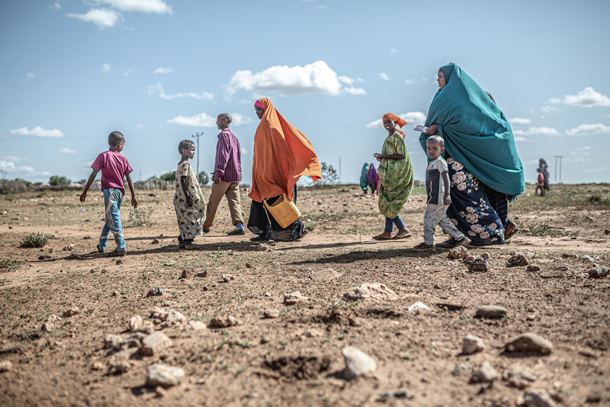
36 year old Hoden Abdi Iwal walks with six of her children to collect water in Gilo, Ethiopia. The ongoing drought has caused the family to lose their crops and livestock, making it very difficult for the family to survive. The Horn of Africa continues to face devastating droughts, causing alarming food security conditions for millions of people in the region. (Photo: Pablo Tosco, Oxfam International)
2019 was a year of climate-related disasters in the developed and developing worlds alike. More people than ever are being forced from their homes because of climate-linked cyclones, sea level rise, and extreme drought, yet the United Nations has not established special legal protections for those displaced by climate disasters. Jesse Young, the Environmental Policy Lead at Oxfam America, joined Living on Earth’s Bobby Bascomb to talk about the most vulnerable populations and the responsibility that rich nations have to help low-income countries cope.
Transcript
CURWOOD: It’s Living on Earth, I’m Steve Curwood.
2019 was a year of climate-related disasters, from flashfloods in the Midwestern US to wildfires in California and Australia. And tropical cyclones killed thousands of people in southern Africa and the Philippines. Scientists forecast more extreme weather events in our warming world, potentially displacing hundreds of millions of people worldwide. But climate change refugees are not recognized by international law and the United Nations doesn’t offer them any additional protections. But people are 3 times more likely to be displaced by climate related disasters than by conflict or war, which does allow victims to claim refugee status. Some 20 million people are displaced from their homes each year as a result of climate disruption and those in small island developing states are among the most vulnerable where now every year rising waters force roughly 5 percent of them to abandon their homes. In December at COP 25 in Madrid, Omar Figueroa, environment minister for Belize, spoke to the conference. He was representing low-lying and small island states.
FIGUEROA: Countries such as Tuvalu and Kiribati are literally at risk of disappearing because of sea level rise. Loss and damage is not an idea that is floating. Visit any of our sister islands and you will see and feel what we are talking about.
CURWOOD: Indeed, residents of Kiribati say they are struggling to survive on the island and must face the difficult decision to leave.
WOMAN 1: I have no choice. No other choice, if tsunami coming or high tides affecting our water, how can we survive for the future?
WOMAN 2: The most disastrous thing in Kiribati right now is the rising of the sea. If you look around you now you see sea walls. The tide just keep on coming and taking away our lands.
CURWOOD: Living on Earth’s Bobby Bascomb asked Jesse Young, the policy lead in climate change at Oxfam America about where most climate refugees are coming from.
BASCOMB: Where are the hotbeds for refugees being displaced because of climate?
YOUNG: A lot of them come in Asia and that's obviously because 60% of the world's population lives in Asia. You also have a lot of mega cities in urban centers in Asia tend to be located in coastal areas, low lying coastal areas that are most vulnerable to storm surge and cyclones and floods. It also tends to be where a lot of the world's most extreme poverty is. So if you combine a growing incidence of extreme weather with concentrated poverty and large groups of people, you get a result like this.
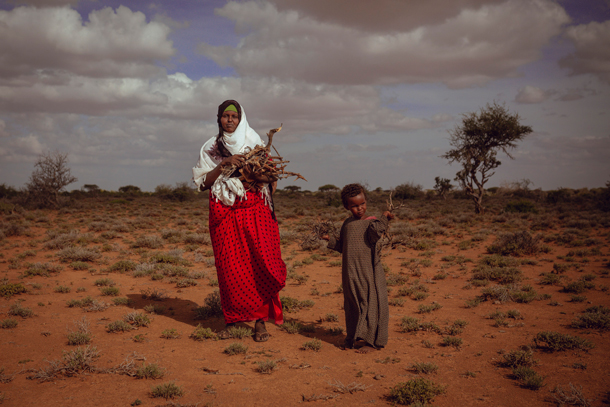
A mother and her son walk far distances to collect firewood in Somalia. Her family has been displaced since the country’s 2017 drought, losing all of their livestock. Somalia remains on the edge of a humanitarian catastrophe as continuing drought means very little recovery and resilience for millions of Somalis who have lost their livelihoods to adequate food and water sources. (Photo: Vincent Best, Oxfam International)
BASCOMB: Are they ending up in refugee camps or in cities and how is that working out for them?
YOUNG: Depending on where you are usually you will be displaced within your country. We refer to these people as internally displaced persons. These are people who've been forced to leave their homes but stay within the borders of the country that they reside in. In smaller countries or in regions bordering other nations, you have people fleeing across borders into other countries. Some people do end up in refugee camps. More often people just end up fleeing into cities, especially if they're fleeing rural areas or dealing with a loss of arable land, they just end up as displaced people ringing larger cities.
BASCOMB: And are they finding jobs there? I mean, I imagine if you have a massive influx of people into cities, it must be a real burden to those cities that probably aren't prepared for it.
YOUNG: We know that when people are displaced because of climate change, they are usually economically marginalized. If they have children, their children have a tougher time finding an education and people who are displaced due to climate change, have a much higher likelihood of falling into intergenerational cycles of poverty, obviously, because they've lost their social capital, their homes, their belongings, their accumulated wealth, If they had it to begin with.
BASCOMB: And what about the social burdens of moving and being displaced from your homes?
YOUNG: It can be really severe; women are more vulnerable when they're displaced due to climate change. While women constitute 43% of smallholder farmers, they're typically more responsible for being caregivers for children and the sick and the elderly, they're more responsible, generally speaking, for finding food for their families. So when they are displaced, they have less ability to do all of those things. They're also much more vulnerable to sexual exploitation and abuse as are their children. So it's a profound social dislocation, even in environments where countries have tried to take populations and preemptively relocate them. It's really tough to reintegrate people. People who’ve built social bonds, they know their community and sort of pulling them out and putting them somewhere new is really difficult to adapt to, as you were, I can probably imagine.
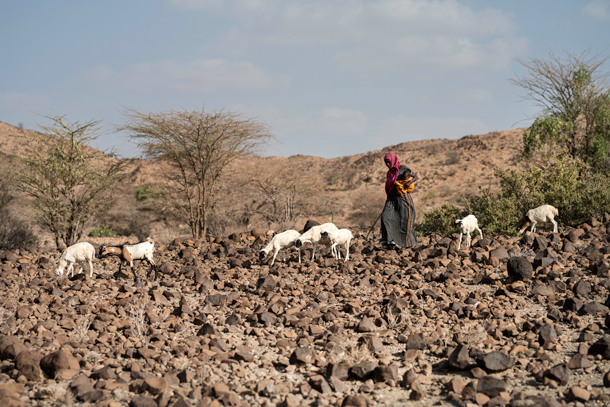
An Ethiopian farmer grazes flocks of animals. Droughts in Ethiopia have been at their peak high since 2008. (Photo: Kieran Doherty, Oxfam International)
BASCOMB: Yeah, yeah, exactly. Well, we did a story last year that made the case that a lot of migrants turning up on our southern border from Central America could be considered climate refugees. You know, they're dealing with drought and the collapse of subsistence agriculture there. Is that something you guys looked into?
YOUNG: Yeah, Oxfam America has done a lot of work on folks fleeing the dry corridor countries. Obviously, there's an enormous amount of deprivation in that region, in Guatemala in 2019 alone, 78% of the corn and bean harvest was lost. There have been droughts of historic length due to an extended El Nin ̃o cycle in that part of the world. So people are fleeing their homes due to crime, loss of livelihoods, loss of foods. It's a complex mix of factors obviously. It's difficult to determine any one case if there's one specific reason why someone leaves their home. But I think it's fair to say that there's a profound climate dimension of why people are fleeing their homes in El Salvador, Guatemala, Nicaragua.
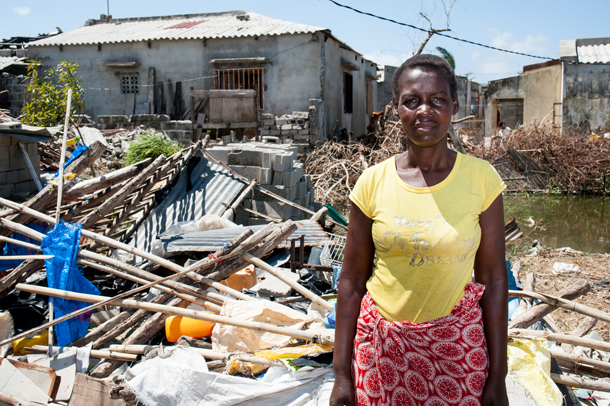
Angelica stands next to her home after it was destroyed by last year’s Cyclone Idai in Mozambique. (Photo: Christian Jepsen, EU Civil Protection and Humanitarian Aid, Flickr, CC BY-NC-ND 2.0)
BASCOMB: And we talked about Asia. What about the parts of Africa are you seeing this problem manifests there?
YOUNG: One of the hotspots is actually the Horn of Africa. So this is far East Africa, Ethiopia, Somalia, South Sudan and Sudan. Saw 3.8 million people displaced by conflict and a million people displaced by extreme weather disasters in 2018. There's been a series of intense droughts in that part of the world. So this is, as is often the case, just exacerbating existing civil wars and violence and just making the displacement effect all that more worse, more and more people being forced to flee their homes, because of the drought.
BASCOMB: What about developing countries like Bangladesh, for example, that are just, you know, synonymous with sea level rise and flooding? I mean, to what degree is the government there able to address this problem for the people and what level of responsibility should they have?
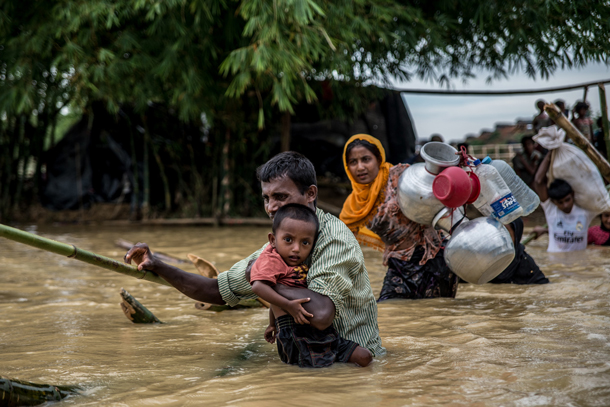
A father carries his son across a broken bamboo bridge on the edge of Balhukai camp, Bangladesh. The 2019, South Asia experienced some of the worst floods in years, forcing millions of people from their homes and threatening their lives. (Photo: Aurrelie Marrier, Oxfam International)
YOUNG: One of the great inequities of climate change is while it infects the entire planet, it does not affect everyone equally, most of these countries had very little to do with putting the emissions in the atmosphere that are changing the climate. That said they're the ones to feel the brunt of it and the most severe impacts. Of course, I think it's important to point out that people aren't just being acted on by climate change in the poor in developing world. They have agency, they’re responding in this on their own and their governments are doing their best to adapt. This is not a question of just helplessness on their part. Bangladesh has actually done a whole lot to adapt to climate change and trying to better protect its citizens. There was a cyclone in 2018 that displaced a huge amount of people in Bangladesh, but most of those people were preemptively evacuated, meaning the government came along and said we know this is coming you have to leave your homes now, far fewer people will die and be injured as a result. So they are adapting, they're putting new laws in place, they're working with international donors to make sure that their populations are less vulnerable. But there's only so much you can ask a very, very poor country to do without additional resources on their own.
BASCOMB: Well, that begs the question, who should be held responsible for the displacement and helping people resettle?
YOUNG: It's hard to argue against the notion that developed countries bear most of the burden here and should be most responsible for generating the resources to help countries transition. We have to keep in mind the climate is a really durable system and the pollution we put there persists for decades to come. And it's a question of adapting and being more resilient to that. But we need to make sure the countries that are feeling those impacts now have the financial resources and the technical resources to meet that challenge and by no one's measure are financial flows from the developed world significant enough to meet that. The total amount of funding flowing from developed countries for climate change is still much, much smaller than it needs to be from both public and private sources.
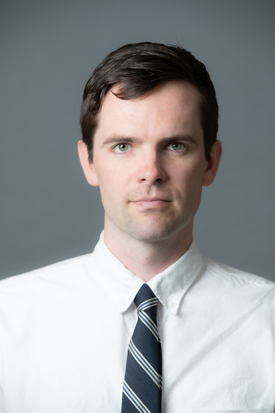
Jesse Young is the Climate Policy Lead at Oxfam America. (Photo: Oxfam America)
BASCOMB: Well, now looking ahead to 2020 what are you hoping to see this year that could improve the situation for the world's refugees?
YOUNG: Two big picture things. One, we have this big international climate agreement called the Paris Agreement and we are looking for countries to really step up their climate pledges. The way Paris works is countries come to the table with what they believe they can do to reduce emissions. We need countries to do far more and especially the big developed and developing countries. You know, this is the Australias, the Indias, the Chinas, the EU need to do a lot more than they are right now to reduce emissions, especially for a country like the United States it's presently withdrawing from the Paris Agreement. The second thing is countries need to step forward with more financial resources. As I was saying earlier, a lot of this stuff is baked into the climate system already and countries need help. They need financial help to relocate people protect people make their economies more climate proof. Because right now, we just don't have enough resources in the system to adequately care for the millions of people being affected by climate change. So more climate ambition and more money, basically.
CURWOOD: Jesse Young is the Policy Lead in Climate Change at Oxfam America, speaking with Living on Earth’s Bobby Bascomb.
Links
Click here for OXFAM International’s study on climate-fueled displacement
Click here to read the Alliance of Small Island States’ Closing Statement for COP25
Living on Earth wants to hear from you!
Living on Earth
62 Calef Highway, Suite 212
Lee, NH 03861
Telephone: 617-287-4121
E-mail: comments@loe.org
Newsletter [Click here]
Donate to Living on Earth!
Living on Earth is an independent media program and relies entirely on contributions from listeners and institutions supporting public service. Please donate now to preserve an independent environmental voice.
NewsletterLiving on Earth offers a weekly delivery of the show's rundown to your mailbox. Sign up for our newsletter today!
 Sailors For The Sea: Be the change you want to sea.
Sailors For The Sea: Be the change you want to sea.
 The Grantham Foundation for the Protection of the Environment: Committed to protecting and improving the health of the global environment.
The Grantham Foundation for the Protection of the Environment: Committed to protecting and improving the health of the global environment.
 Contribute to Living on Earth and receive, as our gift to you, an archival print of one of Mark Seth Lender's extraordinary wildlife photographs. Follow the link to see Mark's current collection of photographs.
Contribute to Living on Earth and receive, as our gift to you, an archival print of one of Mark Seth Lender's extraordinary wildlife photographs. Follow the link to see Mark's current collection of photographs.
 Buy a signed copy of Mark Seth Lender's book Smeagull the Seagull & support Living on Earth
Buy a signed copy of Mark Seth Lender's book Smeagull the Seagull & support Living on Earth

